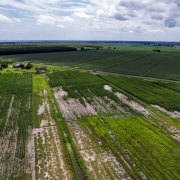U.S. EPA Avoids Stricter Water Pollution Standards for Gulf of Mexico
Court decision makes it easier for EPA to leave nutrient pollution control to Mississippi River Basin states.

By Codi Kozacek
Circle of Blue
Ever since 1972, when scientists first found troubling evidence of low oxygen levels during a survey of the Gulf of Mexico, a lifeless expanse of water has spread throughout the Gulf nearly every summer. Fish, shrimp, and other aquatic animals disappear from an area that has come to be known as the “dead zone.” Researchers found that the dead zone, spanning thousands of square kilometers from the mouth of the Mississippi River in an area as large as Connecticut last year, affects the Gulf’s $US 2.8 billion fishery.
The source of the dead zone was readily identified as massive algal blooms, fed by nutrient-rich water drained from the nation’s heartland, that suck up the Gulf’s oxygen when they die and decompose.
–Matt Rota, senior policy director
Gulf Restoration Network
The solution has not been so easily developed. Earlier this month, in a crucial lawsuit brought by environmental organizations, arguably the clearest path to eliminating algal blooms and reviving a once abundant coastal fishery was turned away by a Federal Appellate Court in New Orleans.
The case, Gulf Restoration Network v. McCarthy, was filed in 2012 by the New Orleans-based Gulf Restoration Network and other regional environmental groups. The lawsuit sought to compel the EPA to determine if specific, numeric limits on the levels of algae-producing nitrogen and phosphorus allowed in the Mississippi River are required to restore the Gulf of Mexico. If the EPA determines that the limits are required, the agency would be obligated to enact them—an action the agency and most states have so far avoided.
The plaintiffs argue that numeric limits—standards that say how many milligrams of the nutrients can be present in each liter of river water, for example—are key to controlling pollution in the Mississippi River Basin and reducing the dead zone. The plaintiffs won the argument in September 2013, when a Federal District Court judge in New Orleans ordered the EPA to make a decision about whether or not numeric limits are necessary.
On April 7, though, three justices of the Fifth Circuit Court of Appeals reversed the lower court and ruled that the EPA need only provide a “reasonable explanation” for refusing to make the determination. The lawsuit now goes back to the district court, which will decide if the agency’s explanation is itself reasonable.

The latest court decision is a setback for efforts to restore aquatic health and reduce the size of the dead zone in the Gulf of Mexico, but it also maintains that the EPA’s decisions on the matter are not “immune” to judicial scrutiny, according to the Natural Resources Defense Council, which represented the environmental groups in the case.
“This gives us a chance to further clarify arguments about how the Clean Water Act requires EPA to give the public straight answers on whether federal action is needed to address the problem, since state efforts to address this problem have been too weak or nonexistent to get the job done,” Ann Alexander, senior attorney for the Natural Resources Defense Council, said in a statement following the ruling. “Waterways across this nation are being mucked to the point of threatening drinking water supplies.”
The court decision reaffirms the federal government’s backseat role to the states in determining water quality standards and regulations. Many states have been reluctant to impose regulations to control nutrient pollution, especially on the agricultural industry that is responsible for more than 70 percent of the nitrogen and phosphorus flowing to the Gulf of Mexico, according to the USGS.
–Ann Alexander, senior attorney
Natural Resources Defense Council
A notable exception is Ohio, which earlier this month passed a law banning certain fertilizer practices linked to excessive nutrient runoff. The restrictions, however, apply only to farms in the western Lake Erie basin—not those in the Mississippi River basin—and came after a toxic algae bloom in the lake last summer shut down drinking water supplies for more than 400,000 people in Toledo. Nutrient pollution also threatens drinking water in Des Moines, Iowa, where the city’s water utility filed a lawsuit in March against surrounding farm communities to reduce nitrogen runoff.
Conservationists say the EPA must step in to address these problems more directly where the states have failed, but the agency has instead relied on voluntary incentive programs to help states reduce nutrient runoff. So far, these programs have shown little effect in the Gulf of Mexico. The dead zone has exceeded 14,000 square kilometers on average, marking no appreciable decline since the release of a plan to reduce it in 2001. The EPA and a regional task force formed to implement the plan announced in February that they are delaying a goal to achieve a 5,000-square-kilometer dead zone from 2015 until 2035.
“The task force has repeatedly been pushing back the dates for seeing results, and this was yet another case,” the NRDC’s Alexander told Circle of Blue. “The U.S. EPA has repeatedly used exactly the same sorts of voluntary strategies that time and again have been proven not to work. Sadly, it was predictable that they would not work again.”

20 More Years to Curb Dead Zone
Plans released by the regional Gulf Hypoxia Task Force in 2013 estimate that Mississippi River Basin states need to make a 45 percent reduction in nitrogen and phosphorus from the average 1980 to 1996 levels in order to reach the 5,000-square-kilometer goal. Current action to meet these targets rests heavily on the creation of state nutrient management plans.
A 2014 review by the EPA Office of Inspector General, however, found that most of the 12 states in the basin are making little headway toward meaningful action in their management plans. Iowa was the only state to commit to a 45 percent reduction in its nitrogen and phosphorus discharges, but it has no timeline for the reduction and is using only voluntary measures. In 2009, a separate Inspector General report said the EPA needed to accelerate the creation of numeric water quality standards, which would outline the maximum amount of nutrients allowed by law in Mississippi River Basin waterways.
–U.S. EPA
“If we had an infinite amount of money to throw on it, we could probably rely on voluntary mechanisms because we could pay enough to make it worthwhile to make sure nitrates and phosphorus don’t get into local rivers and eventually the Mississippi River,” Matt Rota, senior policy director at the New Orleans-based Gulf Restoration Network, told Circle of Blue. “But in a time of low budgets and cost-cutting, we basically need to have a floor and some basic practices that all farmers need to implement.”
Rota said numeric nutrient standards would provide a minimum bar to meet to ensure healthy ecosystems, and should be employed jointly with incentive programs.
“EPA is trying to rely on these nutrient reduction strategies without any sort of accountability mechanism and goals and timelines with suitable carrots and sticks,” Rota continued. “I just don’t see us getting to where we need to be, and that’s a clean Mississippi River and a healthy Gulf.”
The EPA cited a lack of resources as one of the reasons behind the Gulf dead zone goal extension.
“The Task Force extended the deadline due to the enormity of the work and the resources needed to vastly improve water quality in very large bodies of water like the Mississippi River and the Gulf of Mexico,” the agency said in a statement to Circle of Blue in February. “When reaffirming its water quality goal in 2008, the Task Force recognized that securing resources would be a challenge and qualified its goal statement accordingly.”

Voluntary Conservation Programs Get $US 10 Million
The Mississippi River Basin Healthy Watersheds Initiative (MRBI), run by the federal Natural Resources Conservation Service, is one of the most direct funding mechanisms targeting nutrient reduction practices in the region. The program helps farmers in targeted watersheds implement voluntary conservation measures through financial and technical support. Since its creation in 2009, MRBI has improved more than 1 million acres, according to the NRCS.
On April 7, the program committed to spend $US 10 million on conservation efforts this year, in addition to $US 18.5 million dedicated to projects in fiscal year 2015. The additional money will go to 27 new high-priority watersheds in 10 of the 12 states within the Mississippi River Basin and will support 13 previously identified watersheds. Over the next four years, the program will spend a total of $US 100 million on conservation efforts in the basin.
“We know that when we target our efforts to the places most in need, we see stronger results,” U.S. Agriculture Secretary Tom Vilsack said in a statement following the funding announcement. “These projects focus on watersheds in need, where we have opportunities to work with partners and farmers to get conservation work on the ground.”
A news correspondent for Circle of Blue based out of Hawaii. She writes The Stream, Circle of Blue’s daily digest of international water news trends. Her interests include food security, ecology and the Great Lakes.
Contact Codi Kozacek










You did not mention a very important part. In September 2013 a judge gave EPA six months to explain why nutrient pollution is not covered under the CWA. By calling it a nutrient and blaming it on the runoffs from farms and cities, nobody seems to understand that this also means that the nitrogenous waste (urine and proteins) in sewage is also not required to be treated under the CWA. Two weeks before this six months deadline EPA asked a different court for a stay and this court indeed gave EPA a way out not having to explain why it, by using the 5-day, instead of its full 30-day value, of the BOD (Biochemical Oxygen Denand) test, not only ignored 60% of the oxygen exerting pollution, but also all the nitrogenous (urine and protein) waste in sewage, while this waste also is a fertilizer for algae and thus contributes to the dead zones, now occuring in most open waters, besides the Gulf. Fortunately for the EPA this apparently is too difficult to understand and that all attempts to correct this essential test failed during the past 33 years failed. Environmental groups better should spent their money on educating (starting with the media) their representatives in Washington, so they can hold EPA accountable for failing to implement the CWA as was intended. Trying to do this with lawsuits, not only proved to be a waste of money, but more important a waste of time.